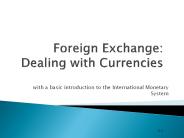Disentangling Two Explanations for Biased Information Exchange in Mixed-Motive Decision-Making Groups - PowerPoint PPT Presentation
1 / 18
Title:
Disentangling Two Explanations for Biased Information Exchange in Mixed-Motive Decision-Making Groups
Description:
Disentangling Two Explanations for Biased Information Exchange in Mixed-Motive Decision-Making Groups ... a communication plan? How do congruent and incongruent ... – PowerPoint PPT presentation
Number of Views:93
Avg rating:3.0/5.0
Title: Disentangling Two Explanations for Biased Information Exchange in Mixed-Motive Decision-Making Groups
1
Disentangling Two Explanations for Biased
Information Exchange in Mixed-Motive
Decision-Making Groups
- Gwen M. Wittenbaum
- Christine Gockel
- Amber Raile
Andrea B. Hollingshead
University of SOUTHERN CALIFORNIA
Michigan State University
2
Framework for Hidden Profile ParadigmWittenbaum,
Hollingshead, Botero (2004)
INPUT
PROCESS
OUTPUT
Features of Context
What Information Is Mentioned
Group Decision Quality
Info distribution Group task Group
composition Member qualities Temporal
features Discussion procedures
Amount of unshared relative to shared information
Discovery of Hidden Profile
3
Motivated Information Sharing FrameworkWittenbaum
, Hollingshead, Botero (2004)
OUTPUTS
PROCESSES
TASK
Group Decision Quality
What Information Is Mentioned
INPUTS
Member Influence
How Information Is Mentioned
Features of Context
Member Goals
SOCIAL
To Whom Information Is Mentioned
Member Relations
4
Empirical Evidence
- Experiment 1 Mixed-motive group decisions
- How do members of mixed-motive decision-making
groups share information? - Experiment 2a Anticipated group decision
- Biased cognition or strategic communication?
5
Experiment 1 Info Distribution
Shared Info Drug A (1, 1-) Drug B (1, 1-)
Drug C (1, 1-)
Unshared Info Drug A (3, 1-) Drug B (1,
1-) Drug C (1, 1-)
Unshared Info Drug A (1, 1-) Drug B (1,
1-) Drug C (3, 1-)
Unshared Info Drug A (1, 1-) Drug B (3,
1-) Drug C (1, 1-)
Drug A Advocate
Drug B Advocate
Drug C Advocate
6
Exp 1 Preference Congruent Incongruent
Information
Shared Info Drug A (1, 1-) Drug B (1, 1-)
Drug C (1, 1-)
Unshared Info Drug A (1, 1-) Drug B (3,
1-) Drug C (1, 1-)
Preference-Congruent Information
Preference-Incongruent Information
Drug B Advocate
7
Experiment 1 Strategic SharingAre members
strategic in WHAT info they mention?
8
Experiment 1 Summary
- Strategic information sharing in mixed-motive
decision-making groups - Members favor unshared information.
- Members favor preference-congruent information.
- Next step
- Biased cognition or strategic communication?
- Separate preferences and incentives.
9
Experiment 2a Congruent Members
Shared Info Drug A (1, 1-) Drug B (1, 1-)
Drug C (1, 1-)
Unshared Info Drug A (4, 1-) Drug B (1,
2-) Drug C (1, 2-)
Unshared Info Drug A (1, 2-) Drug B (1,
2-) Drug C (4, 1-)
Unshared Info Drug A (1, 2-) Drug B (4,
1-) Drug C (1, 2-)
Drug B Drug B
Drug C Drug C
Drug A Drug A
I like I get for
10
Experiment 2a Incongruent Members
Shared Info Drug A (1, 1-) Drug B (1, 1-)
Drug C (1, 1-)
Unshared Info Drug A (4, 1-) Drug B (1,
2-) Drug C (1, 2-)
Unshared Info Drug A (1, 2-) Drug B (1,
2-) Drug C (4, 1-)
Unshared Info Drug A (1, 2-) Drug B (4,
1-) Drug C (1, 2-)
Drug B Drug C (or A)
Drug C Drug A (or B)
Drug A Drug B (or C)
I like I get for
11
Experiment 2a Procedure
CONGRUENT
INCONGRUENT
STEP 1 Instructions
Anticipate group decision (choose best drug)
STEP 2 Drug Info Pref 1
I like Drug B
I like Drug B
STEP 3 Evaluation
Evaluate each piece of information.
STEP 4 Incentive
I get for Drug B
I get for Drug A
Identify pieces of info planned for communication
STEP 5 Plan
STEP 6 Preference 2
I like Drug B
I like Drug B
12
Experiment 2a Congruent Members
STEP 3 EVALUATION
STEP 5 PLAN
13
Experiment 2a Incongruent Members
STEP 5 PLAN
STEP 3 EVALUATION
14
Experiment 2a Incongruent Members
STEP 5 PLAN
STEP 3 EVALUATION
15
Experiment 2a Summary
- Biased Cognition or Strategic Communication?
- Incongruent members cognitively favored
different information than they planned to
communicate. - Members developed a communication strategy, but
- Next steps
- Do members spontaneously develop a communication
plan? - How do congruent and incongruent members actually
share information during interaction?
16
Experiment 2b Procedure
CONGRUENT
INCONGRUENT
STEP 1 Instructions
Anticipate group decision (choose best drug)
STEP 2 Drug Info Pref 1
I like Drug B
I like Drug B
STEP 3 Evaluation
Evaluate each piece of information.
STEP 4 Incentive
I get for Drug B
I get for Drug A
Recall information from the Drug Profiles
STEP 5 Recall
STEP 6 Preference 2
I like Drug B
I like Drug B
17
Experiment 2a Summary
- Biased Cognition or Strategic Communication?
- Incongruent members cognitively favored
different information than they planned to
communicate. - Members developed a communication strategy, but
- Next steps
- Do members spontaneously develop a communication
plan? - How do congruent and incongruent members actually
share information during interaction?
18
Experiment 3 Decision-Making Dyads
Congruent Member I like Drug A I get for
Drug A
Incongruent Member I like Drug C I get for
Drug B































